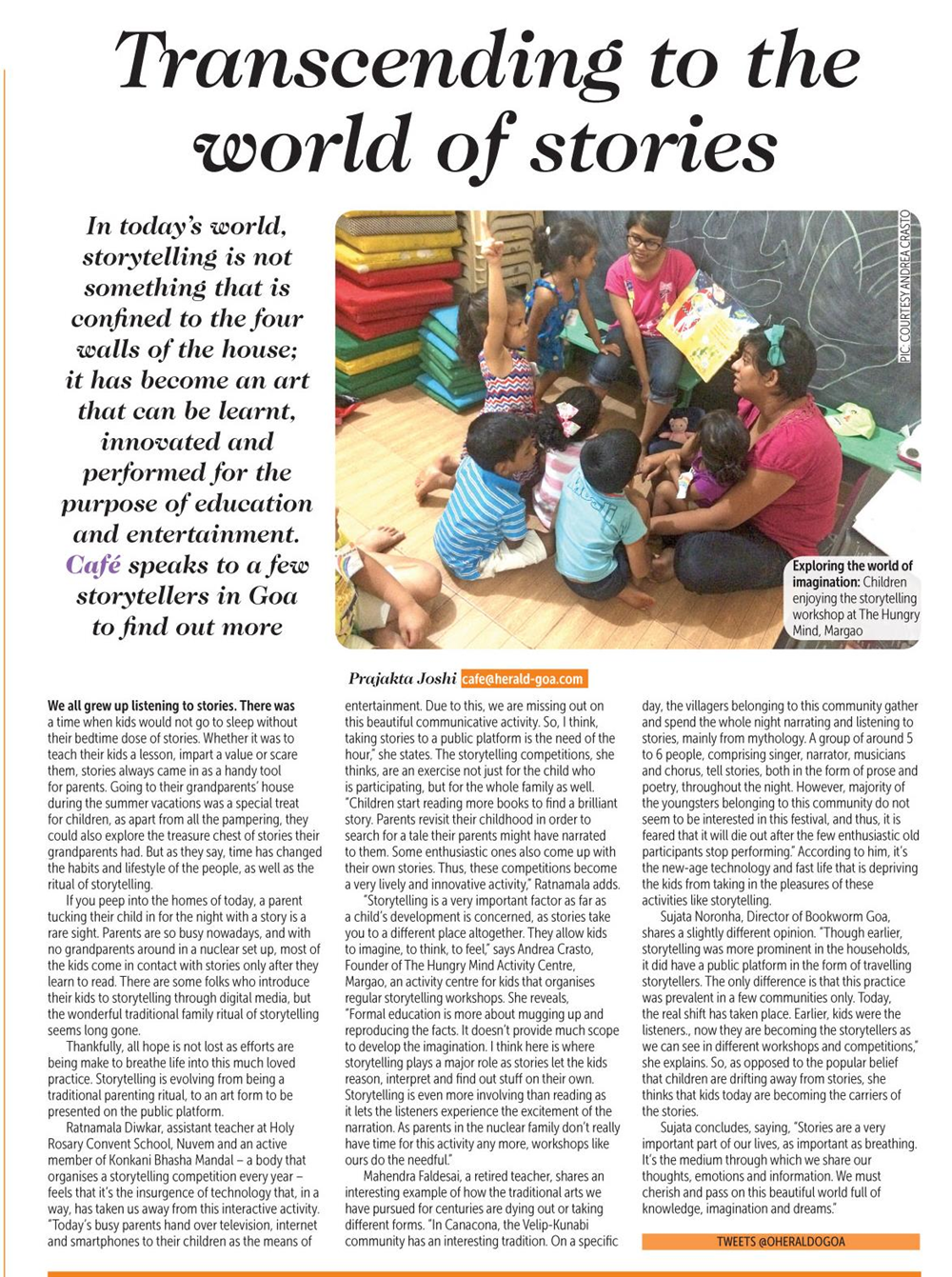In today’s world, storytelling is not something that is confined to the four walls of the house; it has become an art that can be learnt, innovated and performed for the purpose of education and entertainment. Café speaks to a few storytellers in Goa to find out more
We all grew up listening to stories. There was a time when kids would not go to sleep without their bedtime dose of stories. Whether it was to teach their kids a lesson, impart a value or scare them, stories always came in as a handy tool for parents. Going to their grandparents’ house during the summer vacations was a special treat for children, as apart from all the pampering, they could also explore the treasure chest of stories their grandparents had. But as they say, time has changed the habits and lifestyle of the people, as well as the ritual of storytelling.
If you peep into the homes of today, a parent tucking their child in for the night with a story is a rare sight. Parents are so busy nowadays, and with no grandparents around in a nuclear set up, most of the kids come in contact with stories only after they learn to read. There are some folks who introduce their kids to storytelling through digital media, but the wonderful traditional family ritual of storytelling seems long gone.
Thankfully, all hope is not lost as efforts are being make to breathe life into this much loved practice. Storytelling is evolving from being a traditional parenting ritual, to an art form to be presented on the public platform.
Ratnamala Diwkar, assistant teacher at Holy Rosary Convent School, Nuvem and an active member of Konkani Bhasha Mandal – a body that organises a storytelling competition every year – feels that it’s the insurgence of technology that, in a way, has taken us away from this interactive activity.
“ Today’s busy parents hand over television, internet and smartphones to their children as the means of entertainment. Due to this, we are missing out on this beautiful communicative activity. So, I think, taking stories to a public platform is the need of the hour,” she states. The storytelling competitions, she thinks, are an exercise not just for the child who is participating, but for the whole family as well.
“ Children start reading more books to find a brilliant story. Parents revisit their childhood in order to search for a tale their parents might have narrated to them. Some enthusiastic ones also come up with their own stories. Thus, these competitions become a very lively and innovative activity,” Ratnamala adds.
“ Storytelling is a very important factor as far as a child’s development is concerned, as stories take you to a different place altogether. They allow kids to imagine, to think, to feel,” says Andrea Crasto, Founder of The Hungry Mind Activity Centre, Margao, an activity centre for kids that organises regular storytelling workshops. She reveals, “ Formal education is more about mugging up and reproducing the facts. It doesn’t provide much scope to develop the imagination. I think here is where storytelling plays a major role as stories let the kids reason, interpret and find out stuff on their own.
Storytelling is even more involving than reading as it lets the listeners experience the excitement of the narration. As parents in the nuclear family don’t really have time for this activity any more, workshops like ours do the needful.” Mahendra Faldesai, a retired teacher, shares an interesting example of how the traditional arts we have pursued for centuries are dying out or taking different forms. “ In Canacona, the Velip- Kunabi community has an interesting tradition. On a specific day, the villagers belonging to this community gather and spend the whole night narrating and listening to stories, mainly from mythology. A group of around 5 to 6 people, comprising singer, narrator, musicians and chorus, tell stories, both in the form of prose and poetry, throughout the night. However, majority of the youngsters belonging to this community do not seem to be interested in this festival, and thus, it is feared that it will die out after the few enthusiastic old participants stop performing.” According to him, it’s the new- age technology and fast life that is depriving the kids from taking in the pleasures of these activities like storytelling.
Sujata Noronha, Director of Bookworm Goa, shares a slightly different opinion. “ Though earlier, storytelling was more prominent in the households, it did have a public platform in the form of travelling storytellers. The only difference is that this practice was prevalent in a few communities only. Today, the real shift has taken place. Earlier, kids were the listeners., now they are becoming the storytellers as we can see in different workshops and competitions,” she explains. So, as opposed to the popular belief that children are drifting away from stories, she thinks that kids today are becoming the carriers of the stories.
Sujata concludes, saying, “ Stories are a very important part of our lives, as important as breathing. It’s the medium through which we share our thoughts, emotions and information. We must cherish and pass on this beautiful world full of knowledge, imagination and dreams.”

